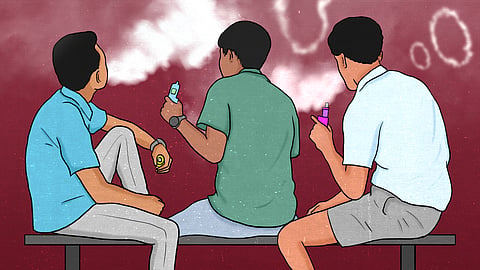Nicotine in their notebooks: The rise of teen vaping in Bengaluru
In Bengaluru, the vape market for school students doesn’t operate in the open. It doesn’t have to. Students aged 16 and 17 have built an access system that’s decentralised, informal, and disturbingly efficient – one that runs through Telegram menus, backroom shop counters, and entire networks of teenagers who know how to ask, whom to ask, and exactly what they’re paying for.
Vaping involves the inhalation of vapour from an electronic device, commonly called an e-cigarette, which typically contains nicotine – a highly addictive stimulant – flavouring, and other chemicals. These devices heat a liquid (often referred to as e-liquid or vape juice) into an aerosol that users inhale.
In India, the use of e-cigarettes is strictly prohibited under the Prohibition of Electronic Cigarettes Act (PECA), 2019. This law bans the production, manufacture, import, export, transport, sale, distribution, storage, and advertisement of e-cigarettes and similar devices. While the Act does not explicitly mention individual use, the Union Health Ministry has clarified that possession of e-cigarettes in any form, quantity, or manner contravenes the provisions of PECA.
Despite the ban, e-cigarettes remain accessible in various parts of the country. “You can go to any street and one in every three smoke shops will have vapes,” said 17-year-old Kunaal*, a Class 11 student. “But they won’t sell it to just anyone. They’ll act like they don’t even know what it is, until you come with someone they trust.”
That trust is often passed down like a trade secret, from a cousin who already vapes, a senior who has a contact, a friend who knows which shop won’t flinch if you ask for a “Strawberry Ice 10K.” First-timers are told to hang around, make small talk, and not to ask too fast. Sellers watch. They remember faces. “After two or three visits, they might open the drawer,” Kunaal said. “But only if they’ve seen you before.”
Vaping has quietly become prevalent among Bengaluru’s school students, facilitated by informal networks, discreet sales tactics, and peer influence. Through platforms like Telegram and backroom shops, teenagers have normalised access to nicotine devices, which are not only illegal but also medically harmful. What starts as a curiosity over fruity flavours quickly develops into daily dependence, driven by misinformation and a lack of regulation.
Drawing from interviews with 11 students as well as educators and a psychotherapist, this report delves into the vaping culture in Bengaluru’s schools, exploring how students access vapes, the role of peer dynamics, and the psychological factors influencing their choices.
A pan-India network of vape sellers
The pricing isn’t arbitrary. Most students know that a Rs 2,000 vape in Bengaluru would cost half that in Delhi. And they act on it. “I’ve spoken to people in Coimbatore, Chennai, Delhi just to compare rates,” said Dhruv*, a Class 11 student, also 17. “We take screenshots of menus, tally prices, and then place bulk orders with whoever is cheapest. It’s like a group project.”

